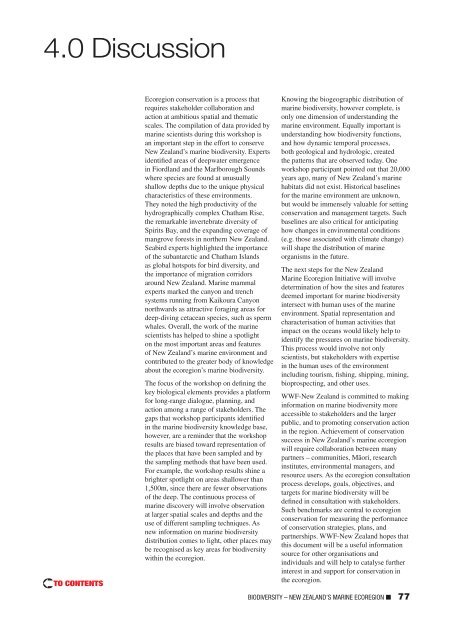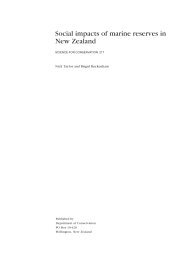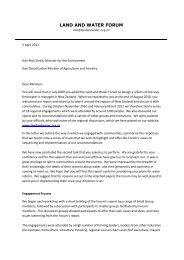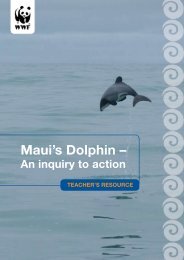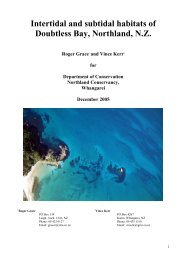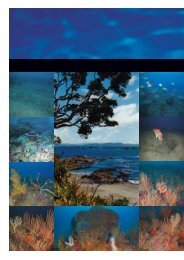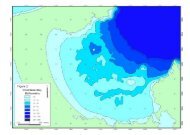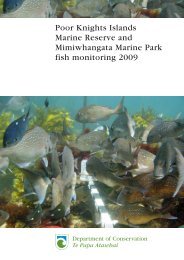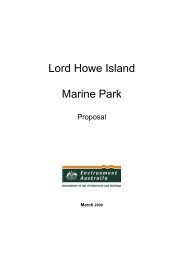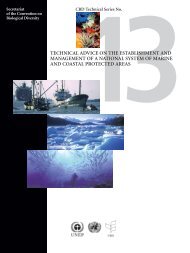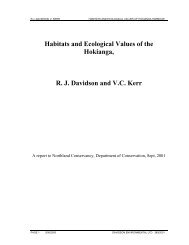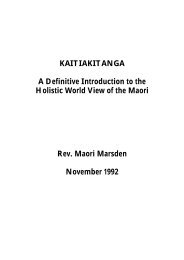WWF Shining a spotlight on the biodiversity of ... - MarineNZ.org.nz
WWF Shining a spotlight on the biodiversity of ... - MarineNZ.org.nz
WWF Shining a spotlight on the biodiversity of ... - MarineNZ.org.nz
Create successful ePaper yourself
Turn your PDF publications into a flip-book with our unique Google optimized e-Paper software.
4.0 Discussi<strong>on</strong><br />
Ecoregi<strong>on</strong> c<strong>on</strong>servati<strong>on</strong> is a process that<br />
requires stakeholder collaborati<strong>on</strong> and<br />
acti<strong>on</strong> at ambitious spatial and <strong>the</strong>matic<br />
scales. The compilati<strong>on</strong> <strong>of</strong> data provided by<br />
marine scientists during this workshop is<br />
an important step in <strong>the</strong> effort to c<strong>on</strong>serve<br />
New Zealand’s marine <strong>biodiversity</strong>. Experts<br />
identified areas <strong>of</strong> deepwater emergence<br />
in Fiordland and <strong>the</strong> Marlborough Sounds<br />
where species are found at unusually<br />
shallow depths due to <strong>the</strong> unique physical<br />
characteristics <strong>of</strong> <strong>the</strong>se envir<strong>on</strong>ments.<br />
They noted <strong>the</strong> high productivity <strong>of</strong> <strong>the</strong><br />
hydrographically complex Chatham Rise,<br />
<strong>the</strong> remarkable invertebrate diversity <strong>of</strong><br />
Spirits Bay, and <strong>the</strong> expanding coverage <strong>of</strong><br />
mangrove forests in nor<strong>the</strong>rn New Zealand.<br />
Seabird experts highlighted <strong>the</strong> importance<br />
<strong>of</strong> <strong>the</strong> subantarctic and Chatham Islands<br />
as global hotspots for bird diversity, and<br />
<strong>the</strong> importance <strong>of</strong> migrati<strong>on</strong> corridors<br />
around New Zealand. Marine mammal<br />
experts marked <strong>the</strong> cany<strong>on</strong> and trench<br />
systems running from Kaikoura Cany<strong>on</strong><br />
northwards as attractive foraging areas for<br />
deep-diving cetacean species, such as sperm<br />
whales. Overall, <strong>the</strong> work <strong>of</strong> <strong>the</strong> marine<br />
scientists has helped to shine a <str<strong>on</strong>g>spotlight</str<strong>on</strong>g><br />
<strong>on</strong> <strong>the</strong> most important areas and features<br />
<strong>of</strong> New Zealand’s marine envir<strong>on</strong>ment and<br />
c<strong>on</strong>tributed to <strong>the</strong> greater body <strong>of</strong> knowledge<br />
about <strong>the</strong> ecoregi<strong>on</strong>’s marine <strong>biodiversity</strong>.<br />
The focus <strong>of</strong> <strong>the</strong> workshop <strong>on</strong> defining <strong>the</strong><br />
key biological elements provides a platform<br />
for l<strong>on</strong>g-range dialogue, planning, and<br />
acti<strong>on</strong> am<strong>on</strong>g a range <strong>of</strong> stakeholders. The<br />
gaps that workshop participants identified<br />
in <strong>the</strong> marine <strong>biodiversity</strong> knowledge base,<br />
however, are a reminder that <strong>the</strong> workshop<br />
results are biased toward representati<strong>on</strong> <strong>of</strong><br />
<strong>the</strong> places that have been sampled and by<br />
<strong>the</strong> sampling methods that have been used.<br />
For example, <strong>the</strong> workshop results shine a<br />
brighter <str<strong>on</strong>g>spotlight</str<strong>on</strong>g> <strong>on</strong> areas shallower than<br />
1,500m, since <strong>the</strong>re are fewer observati<strong>on</strong>s<br />
<strong>of</strong> <strong>the</strong> deep. The c<strong>on</strong>tinuous process <strong>of</strong><br />
marine discovery will involve observati<strong>on</strong><br />
at larger spatial scales and depths and <strong>the</strong><br />
use <strong>of</strong> different sampling techniques. As<br />
new informati<strong>on</strong> <strong>on</strong> marine <strong>biodiversity</strong><br />
distributi<strong>on</strong> comes to light, o<strong>the</strong>r places may<br />
be recognised as key areas for <strong>biodiversity</strong><br />
within <strong>the</strong> ecoregi<strong>on</strong>.<br />
Knowing <strong>the</strong> biogeographic distributi<strong>on</strong> <strong>of</strong><br />
marine <strong>biodiversity</strong>, however complete, is<br />
<strong>on</strong>ly <strong>on</strong>e dimensi<strong>on</strong> <strong>of</strong> understanding <strong>the</strong><br />
marine envir<strong>on</strong>ment. Equally important is<br />
understanding how <strong>biodiversity</strong> functi<strong>on</strong>s,<br />
and how dynamic temporal processes,<br />
both geological and hydrologic, created<br />
<strong>the</strong> patterns that are observed today. One<br />
workshop participant pointed out that 20,000<br />
years ago, many <strong>of</strong> New Zealand’s marine<br />
habitats did not exist. Historical baselines<br />
for <strong>the</strong> marine envir<strong>on</strong>ment are unknown,<br />
but would be immensely valuable for setting<br />
c<strong>on</strong>servati<strong>on</strong> and management targets. Such<br />
baselines are also critical for anticipating<br />
how changes in envir<strong>on</strong>mental c<strong>on</strong>diti<strong>on</strong>s<br />
(e.g. those associated with climate change)<br />
will shape <strong>the</strong> distributi<strong>on</strong> <strong>of</strong> marine<br />
<strong>org</strong>anisms in <strong>the</strong> future.<br />
The next steps for <strong>the</strong> New Zealand<br />
Marine Ecoregi<strong>on</strong> Initiative will involve<br />
determinati<strong>on</strong> <strong>of</strong> how <strong>the</strong> sites and features<br />
deemed important for marine <strong>biodiversity</strong><br />
intersect with human uses <strong>of</strong> <strong>the</strong> marine<br />
envir<strong>on</strong>ment. Spatial representati<strong>on</strong> and<br />
characterisati<strong>on</strong> <strong>of</strong> human activities that<br />
impact <strong>on</strong> <strong>the</strong> oceans would likely help to<br />
identify <strong>the</strong> pressures <strong>on</strong> marine <strong>biodiversity</strong>.<br />
This process would involve not <strong>on</strong>ly<br />
scientists, but stakeholders with expertise<br />
in <strong>the</strong> human uses <strong>of</strong> <strong>the</strong> envir<strong>on</strong>ment<br />
including tourism, fishing, shipping, mining,<br />
bioprospecting, and o<strong>the</strong>r uses.<br />
<str<strong>on</strong>g>WWF</str<strong>on</strong>g>-New Zealand is committed to making<br />
informati<strong>on</strong> <strong>on</strong> marine <strong>biodiversity</strong> more<br />
accessible to stakeholders and <strong>the</strong> larger<br />
public, and to promoting c<strong>on</strong>servati<strong>on</strong> acti<strong>on</strong><br />
in <strong>the</strong> regi<strong>on</strong>. Achievement <strong>of</strong> c<strong>on</strong>servati<strong>on</strong><br />
success in New Zealand’s marine ecoregi<strong>on</strong><br />
will require collaborati<strong>on</strong> between many<br />
partners – communities, Mäori, research<br />
institutes, envir<strong>on</strong>mental managers, and<br />
resource users. As <strong>the</strong> ecoregi<strong>on</strong> c<strong>on</strong>sultati<strong>on</strong><br />
process develops, goals, objectives, and<br />
targets for marine <strong>biodiversity</strong> will be<br />
defined in c<strong>on</strong>sultati<strong>on</strong> with stakeholders.<br />
Such benchmarks are central to ecoregi<strong>on</strong><br />
c<strong>on</strong>servati<strong>on</strong> for measuring <strong>the</strong> performance<br />
<strong>of</strong> c<strong>on</strong>servati<strong>on</strong> strategies, plans, and<br />
partnerships. <str<strong>on</strong>g>WWF</str<strong>on</strong>g>-New Zealand hopes that<br />
this document will be a useful informati<strong>on</strong><br />
source for o<strong>the</strong>r <strong>org</strong>anisati<strong>on</strong>s and<br />
individuals and will help to catalyse fur<strong>the</strong>r<br />
interest in and support for c<strong>on</strong>servati<strong>on</strong> in<br />
<strong>the</strong> ecoregi<strong>on</strong>.<br />
BIODIVERSITY – NEW ZEALAND’S MARINE ECOREGION ■ 77


